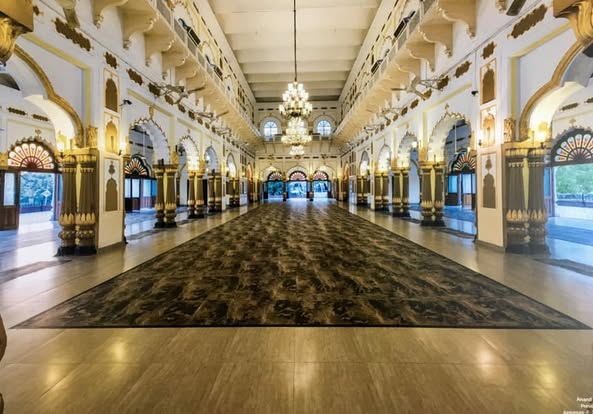Baradari Kaiserbagh: A Majestic Symbol of Awadhi Heritage

Introduction
Baradari Kaiserbagh stands as a testament to the architectural brilliance and cultural opulence of Lucknow. Situated within the historic Kaiserbagh complex, this magnificent structure reflects the grandeur of the Awadhi era. It was built during the reign of Nawab Wajid Ali Shah, the last ruler of Awadh, who envisioned Kaiserbagh as a regal paradise filled with exquisite structures. Today, Baradari Kaiserbagh remains an iconic landmark that attracts historians, architects, and heritage enthusiasts.
The Historical Significance of Baradari Kaiserbagh
The term Baradari originates from Persian, meaning ‘a structure with twelve doors.’ These architectural wonders were common in Mughal and Awadhi designs, often serving as venues for royal gatherings, poetry recitals, and cultural events. It was a focal point in Nawab Wajid Ali Shah’s grand vision for Kaiserbagh, which he intended to be a ‘paradise on earth.’
Following the British annexation of Awadh in 1856, Baradari Kaiserbagh became a crucial site during the Revolt of 1857. The structure witnessed intense battles as Indian revolutionaries fought against British forces. Despite the tumultuous past, the Baradari remains a symbol of resilience and historical pride.
Architectural Splendor of Baradari Kaiserbagh
Baradari Kaiserbagh exemplifies the unique fusion of Mughal, Persian, and Awadhi architectural styles. The structure features twelve arched doorways that ensure excellent ventilation and aesthetic symmetry. Built with white marble, the Baradari showcases intricate carvings, elegant columns, and ornamental motifs that highlight the skilled craftsmanship of the era.
The structure originally functioned as a royal court and a venue for cultural performances. Nawab Wajid Ali Shah, known for his deep love for art and literature, hosted mushairas (poetry gatherings), music performances, and theatrical productions within its walls. The blend of artistry and structural grandeur makes Baradari Kaiserbagh a remarkable architectural jewel.
Cultural and Historical Relevance
Beyond its architectural beauty,it played an essential role in the cultural fabric of Awadh. The Nawab, himself a poet and patron of the arts, transformed the Baradari into a hub of literary and artistic expression. Even today, the structure hosts various cultural events, reviving the old-world charm of Lucknow’s royal past.
During the Revolt of 1857, it became a strategic location for Indian revolutionaries resisting British forces. After the rebellion was suppressed, the British repurposed many parts of Kaiserbagh, but the Baradari survived as a crucial link to Lucknow’s historical narrative.
Baradari Kaiserbagh in Modern Times
Today, Baradari Kaiserbagh remains one of Lucknow’s most revered heritage sites. The government and heritage conservationists have undertaken efforts to restore and maintain its architectural integrity. Tourists, historians, and researchers visit the site to admire its stunning design and learn about its rich history.
In recent years, the Baradari has also served as a venue for cultural programs, including exhibitions, classical music performances, and heritage walks. These initiatives aim to preserve the artistic traditions that once flourished under Nawab Wajid Ali Shah’s patronage.
Tourist Guide to Baradari Kaiserbagh
If you plan to visit Baradari Kaiserbagh, here are some essential details:
- Location: Kaiserbagh, Lucknow, Uttar Pradesh, India
- Visiting Hours: Typically open from morning to evening (confirm with local tourism authorities)
- Entry Fee: Generally free or nominal (varies for special events)
- Best Time to Visit: October to March, when the weather is pleasant
- Nearby Attractions: Rumi Darwaza, Chhatar Manzil, Hussainabad Clock Tower, and Bara Imambara
Why You Should Visit Baradari Kaiserbagh
- Architectural Marvel: A perfect blend of Mughal and Awadhi styles, showcasing fine craftsmanship.
- Historical Importance: A site of crucial events during the Revolt of 1857 and the Nawabi era.
- Cultural Heritage: A hub of art, literature, and classical music performances.
- Photography Paradise: The intricate carvings and marble architecture provide stunning photo opportunities.
- Tranquil Escape: A serene location away from the hustle and bustle of modern life.
Preserving the Legacy of Baradari Kaiserbagh
The conservation is essential to maintaining Lucknow’s rich historical and architectural heritage. Efforts by government bodies and heritage organizations have helped restore parts of the structure, ensuring that future generations can experience its grandeur.
Local heritage groups continue to organize awareness campaigns and cultural events to highlight the significance of the Baradari. By supporting these initiatives and promoting responsible tourism, visitors can contribute to preserving this historical gem.
Conclusion
Baradari Kaiserbagh is more than just a historical monument—it is a symbol of Awadh’s regal past, artistic excellence, and architectural brilliance. Whether you are a history buff, an architecture enthusiast, or a cultural explorer, this magnificent structure offers a glimpse into the bygone era of Nawabs and their unparalleled love for art and culture.
Visiting Baradari Kaiserbagh is not just about witnessing a historical site; it is about experiencing a legacy that continues to inspire and captivate. So, the next time you are in Lucknow, make sure to explore this breathtaking piece of history and immerse yourself in the charm of Awadh’s glorious past.






